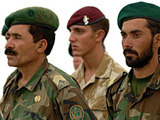Understanding Counterinsurgency Strategy
8 Nov 2010
By Gail Harris for ISN
For months, media coverage of the war in Afghanistan has focused on the failures of counterinsurgency (COIN) at the heart of US President Barack Obama's strategy shift external pageoutlinedcall_made in December 2009. While criticizing the impact of COIN efforts, media outlets have simultaneously latched onto the successes of the stepped-up capture and kill techniques used in recent months. While the "counterinsurgency strategy has shown little success […] what has turned out to work well is an approach American officials have talked much less about: counterterrorism, military-speak for the targeted killings of insurgents from Al Qaeda and the Taliban," external pagestatedcall_made a recent New York Times article.
This media analysis signals a general lack of understanding about COIN strategy, setting up a false dichotomy between COIN and counterterrorism. COIN strategy is more than a 'hearts and minds' campaign; it also includes military operations that uses the more traditional forms of warfare to include counterterrorism efforts as required.
Toward a workable definition
COIN consists of three basic phases: First, neutralize or kill insurgent forces in order to provide a secure and stable environment for the host nation; second, train host nation security forces to successfully deal with external and internal threats; and, finally, turn over all aspects of security operations to the host nation.
In a recent external pageinterviewcall_made, Colonel John Ferrari, the deputy commander for programs of the NATO Training Mission-Afghanistan (NTM-A), elaborated:
COIN is a strategy of warfare which includes the full spectrum of warfare. So it includes everything from reconstruction to reintegration to building the security forces to being with the population, but it also includes killing the enemy […] if the insurgents or enemy doesn't want to be reconciled and they want to fight, then the military here, as part of the COIN strategy, will kill them […] or they can come in and be part of reconciliation.
Thus, what the public and many in the media seem to misunderstand - as illustrated in the NYT excerpt above - is that killing or capturing the enemy is part of the COIN strategy. When he assumed command of NATO troops in Afghanistan in August this year, General David Petraeus put out a detailed COIN Guidance external pagememocall_made. It included 21 points, two of which - "pursue the enemy relentlessly" and "fight hard and fight with discipline" - directly address combat operations.
It appears then that the stepped-up efforts to kill and capture insurgents is not so much a shift away from COIN but a shift of priorities within the COIN strategy itself. This shift itself adheres to the external pageCOIN principlecall_made addressing the need to constantly adapt and change tactics, techniques and procedures as the situation requires. Thus, a shift toward more targeted killings does not mean abandoning the training of Afghan security forces, for example. Instead, the training and fielding of Afghan security force continues. The two objectives are not mutually exclusive, but instead complementary.
Modest gains?
The shift in COIN strategy seems to have merited some successes of late. In September while traveling with reporters, Petraeus outlined how increased counterterrorism efforts have yielded some tangible results. He external pagestatedcall_made that 235 Taliban leaders were either killed or captured in the previous 90 days, along with 1,066 of their followers killed and another 1, 673 detained. NATO forces have also been forthcoming about the increased use of drones and smart weapons to find and kill targets with greater precision.
Additionally, the training of Afghan security forces has shown progress. Sergeant Major Michael Logan of the NTM-A external pagestatedcall_made in a recent interview that training of the external page134,000 man armycall_made had been accomplished ahead of schedule, with external page1,228 coalition and 4,600 Afghancall_made trainers involved. They have been conducting a 'train the trainer' program in order to enable the Afghans to sustain the effort after the NATO trainers are gone. There has also been a major emphasis on developing a strong noncommissioned officer corps, which Logan believes will be the backbone of the Afghan army leadership.
The Afghan police force currently external pagenumberscall_made 106,000 with a target of 109,000 by the end of November. Dr Jack Kem, deputy to the commander NTM-A external pagepointed tocall_made female subscription as a positive sign of change:
There is a goal now to have about 5,000 police officers recruited in the next two years who are women. And I think what the "a-ha" moment is for many of the Afghans: when they realize that it does make sense, culturally, that if you're having border police, or Afghan police who are doing inspections at airports and borders, that it's culturally right to having a woman doing the inspection of another woman.
The biggest obstacles to COIN success will continue to be corruption, literacy, attrition, insurgent safe havens in Pakistan and the July 2011 withdrawal deadline, which encourages the Taliban to wait out NATO forces. During a recent external pageinterviewcall_made, Petraeus said the withdrawal deadline was not set in stone and emphasized that "this is a date when the process begins and is conditions based."
Military commanders' capacity to adapt COIN strategy to evolving challenges on the ground may impact on the withdrawal timetable.

